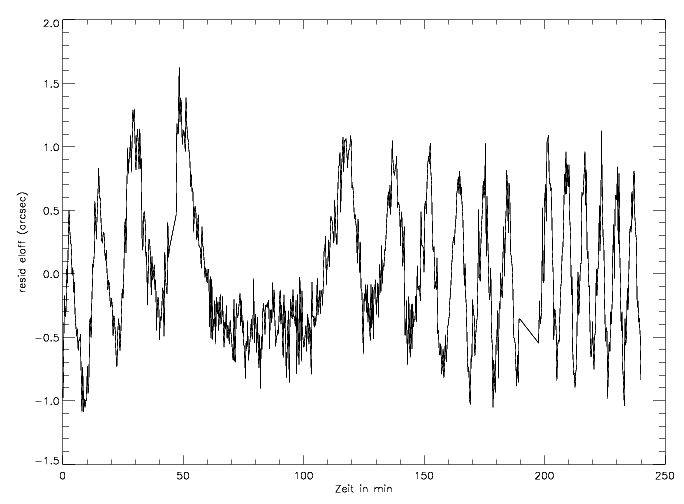TIGRE Telescope
Commissioning

Commissioning
Status (February 2009):Summary (1. 11. 2005):
After re-installation of the telescope at Hamburg Observatory, all necessary tests could been finished successfully. These tests confirmed a good performance, i.e., all specifications as stipulated in the contract are fulfilled.
Optics:
The good performance of the optics has not been changed (see Tests Optics).
Pointing characteristics:
The equations of the HRT pointing model can be found at Tests: Telescope pointing
118 stars were measured. From these observations, the following parameters result [deg]:
AAN = 9.84357e-05
EAN = -0.000376916
AAE = 0.00127938
EAE = 0.00201526
NPAE = -0.000369850
BNP = 0.0772862
AOFS = -0.0643754
EOFS = -0.224928
AES = -0.00104917
AEC = -0.00100729
EES = -0.00712070
EEC = 0.0300027
C1 = 0.00327695
C2 = -0.000595055
C3 = -0.00106464
C4 = -0.000156804
C5 = 6.64768e-05
Note the very small value of NPAE, speaking for a high quality of manufacturing (NPAE is the deviation from 90°
of the angle between the two axes). Bigger values are found for BNP (misalignment between the optical axis and the
telescope axis) and for EEC (tube flexure plus decentering or ellipticity of the elevation encoder).
C4 and C5 are approximately zero and
C2 and C3 are very small.
The standard deviations of the residuals in azimuth and elevation are 3.6" resp. 2.4", speaking for a remarkably good
pointing behaviour of the telescope.




Tracking characteristics:
Oscillations:
During the test phase before overhauling at the Halfmann workshop, an oscillation in elevation with the encoder eigenfrequency
and with variable amplitude was observed. Such kind of oscillation was also observed for the STELLA I and MONET I telescopes
manufactured by Halfmann. An extreme example is depicted in the figure where a stellar tracking measure was done
near the pole. Because of a very low and variable tracking velocity, the eigenfrequency is also very low and
changing. The absence of the oscillation is during meridian passage, the gap at minute 190 is a technical interrupt.

The reason for the oscillation could be found and abolished during the overhauling phase.
Now observations of the same star but with a bit higher
tracking speed, corresponding to oscillation periods of 2.5min in azimuth and 5min in elevation, do not exhibit
this kind of oscillations (see next figure).

Trends:
Tracking loss rates were measured at several celestial positions (auto-guider was switched off):
| Azimuth | Elevation | Tracking loss rate [arcsec/min] | |
|---|---|---|---|
| 80 | 40 | 0,02 | |
| 180 | 40 | 0,13 | |
| 270 | 40 | 0,065 | |
| 0 | 70 | 0,035 | |
| 100 | 70 | 0 | 180 | 70 | 0,16 |
| 270 | 70 | 0,1 | |
| --- | approx. zenith | 0,2 |


